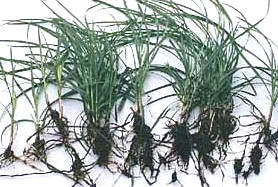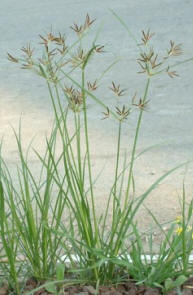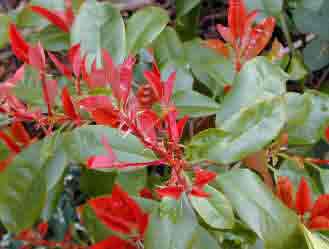Nutgrass – Nut Grass - Purple Nut sedge – Cyperus rutundus. A pest in Lawns and other parts of the garden
Whatever you call it, the plant commonly known as Nutgrass or nut Grass, is set to become one of the most troublesome weeds of US gardens and lawns. Together with this, Nutgrass (Purple Nutsedge) is stating to become a problem in other areas of the world – such as New Zealand.
Whilst it can be a problem in all parts of the garden, Nutgrass is also difficult weed to get rid of in lawns.
Anyone who has had a close encounter with Nutgrass in their lawn, will be aware that whilst it has a few characteristics of certain other coarse grasses, it is not a true grass - even though often found in lawns! Nutgrass is actually a member of the ‘Rush’ family – a sedge.
 Sedges are often associated with damp boggy areas. Nutgrass
certainly need moisture, but is more prevalent in hot
conditions, with full sunlight being it’s favourite growing
conditions.
Sedges are often associated with damp boggy areas. Nutgrass
certainly need moisture, but is more prevalent in hot
conditions, with full sunlight being it’s favourite growing
conditions.
Underground Stems and tubers which are such a problem in the eradication
of Nutgrass.
Nut grass has been documented as being found in more temperate regions, but does not – at present – seem to present such a serious problem in these cooler areas.
These hot, happy, growing conditions will probably give credibility to the assumption that it started life in India.
 The distinct brown flowers of the Nutgrass
The distinct brown flowers of the Nutgrass
Nutgrass - The Invasive Weed
As with many other invasive weeds, Nutgrass spreads by way of underground stems (Rhizomes) and small tubers (Nuts).
Unfortunately, some of the more effective methods of control or eradication are not always practicable for the average gardener - especially if the Nutgrass is in the lawns area. For instance repeated tillage in the summer – which seems to be an effective control –is not often an option, especially if the Nutgrass has invaded a lawn. Regular tillage, which brings the tubers to the surface – or near to – tends to dry out the tubers beyond their natural endurance. (Moisture loss is a quick way to death for Nutgrass tubers. Desiccation can lead to death after just 4 days!)) However, the tillage must take place every three weeks to be effective, so not generally an option for the gardener.
The Nutgrass plant is also susceptible to shading, and shaded conditions, so anything that can be done to increase the competition for sunlight from surrounding plants can be beneficial. This would include having a healthy, strong growing lawn. Regular cropping of an area can have a beneficial effect for Nut grass, for as the crops are removed it then has full access to the available sunlight, moisture in the soil, and available nutrients.
Without doubt, one of the best – non-chemical - ways to slow down the spread of Nutgrass is by increasing competition with other robust plants. This is not a long-term solution, for the other plants will rarely completely dominate it
Whilst, the long slender blades of the Nutgrass plant above ground might seem relatively under control, it is under the surface of the soil where the real problem les. A network of connected – and un-connected – rhizomes, and tubers, can spread the Nutgrass infestation by several yards in a year.
Other weeds can be mistaken for Nutgrass, including other sedges. However, Nutgrass has unmistakable brown flowers, whilst other similar weeds have yellow, green or white flowers.
Mulching either with organic or sheet materials is virtually ineffective for Nutgrass. The sharp pointed new leaves can soon puncture through most sheet materials used in landscape maintenance. Together with this, most mulches assist in retaining soil moisture – a boon form the dormant – and not so dormant - underground tubers.
Management of Nutgrass by using herbicides – weedkillers.
Nutgrass - or Nut Grass - can be controlled or even eradicated (over time) with the use of Glyphosate (Sold as Roundup.)
Glyphosate is often used incorrectly, in that users do not read the instructions properly. Or perhaps read the instructions then ignore them!
Glyphosate has to be applied to plants that are in full growth. This often means allowing weeds to grow to part maturity before spraying! Nutgrass is no exception. It is no use simply spraying the new Nutgrass shoots as they appear, for this will not allow the chemical to be fully translocated (transported) down into the tubers which lurk below soil level. If the tubers are not ‘attacked’ than they will simply start anew. The pant must have enough foliage above ground, to allow enough Glyphosate to be taken in and then to find its way down into the tubers.
This is not a one-off treatment. Complete control of Nutgrass might take several years, for there will be other Nutgrass tubers in the soil, that are not attached to the parent plant! Therein lies one of the major problems in the control of Nutgrass. Glyphosate is not effective on any tubers which are not connected to the green growth of the parent plant.
Whilst the application of Roundup – Glyphosate – will probably kill the treated plant and its attached tubers and any other attached underground growth, it will NOT harm the dormant tubers, which have become separated from the ‘above ground’ foliage! Be prepared for several years of herbicide application! Be patient with the next crop – let it grow enough to allow proper Glyphosate uptake.
If the Nutgrass in your lawn, Glyphosate can still be used – but with care not to ‘treat’ your lawn grasses. The gel form is best for use against Nutgrass in lawns, or perhaps one of the many ‘inventions’ used by experienced or experimenting gardeners. One such way is to pull the foliage of the Nutgrass up through a hole cut in a piece of plywood, thereby spraying the Nutgrass, but not the shielded grass under the plywood!
Another way is to simply cut the lawn grass more often so that the Nutgrass is less obvious. Ostriches have a similar approach to such problems!
Find out how to use Glyphosate properly.
The other option or control of Nutgrass in border areas, is to painstakingly dig up the plant and its attached tubers, then be prepared for new growth from the dormant tubers which will certainly be present in the soil.
Best Selling Gardening Products
Popular Gardening Sections

Problems
Identify Weeds in The Garden - How to deal with weeds. Diseases and Pest which harm your garden and plants, learn how to prevent, deter and erradicate your garden problems.
Garden Problems
Pruning
Pruning Guide. Shrubs flower better with correct pruning. Many illustrations and examples of what to do - and when. Includes evergreens, roses, flowering shrubs, spring flowering shrubs and pruning for stem effect. This is our most viewed and comprehensive section,
Pruning
Gardening Businesses
Gardening Businesses listed in the UK counties and USA states. County and State Listings of businesses involved in Garden supplies and services. If you wish to be added to the Directory, please send us your information. Having problems, use the search box
Businesses
Gardening
In this section you will learn about Gardening Basics, Containers, Landscaping, Propagation and Soil.
Gardening
Gardening Gifts
Gardening Gifts and Reviews, Read Before you Buy
- Gardening Gifts Ideas
- Gifts For Her
- Gifts For Men
- Power Tool Gifts
- Cheap Gifts
- Personalised Gifts
- Wildlife Gifts
- Family Gifts



